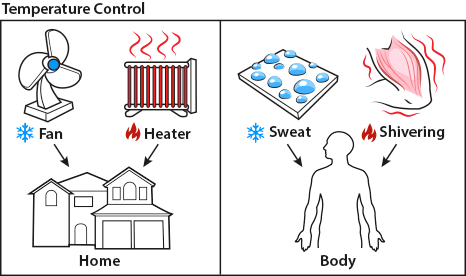WS: Homeostasis
- Due No due date
- Points 100
- Questions 6
- Time Limit None
- Allowed Attempts Unlimited
Instructions

How does your body react to cold?
These people may be having fun in the icy water, but their bodies are struggling to react to the cold. For example, they may begin to shiver. Shivering helps the body return to a stable temperature. The body is always working to achieve stability, or homeostasis.
Homeostasis and Feedback Regulation
When you walk outside on a cool day, does your body temperature drop? No, your body temperature stays stable at around 98.6 degrees Fahrenheit. Even when the temperature around you changes, your internal temperature stays the same.
This ability of the body to maintain a stable internal environment despite a changing environment is called homeostasis. Homeostasis doesn't just protect against temperature changes. Other aspects of your internal environment also stay stable. For example, your body closely regulates your fluid balance. You may have noticed that if you are slightly dehydrated, your urine is darker. That's because the urine is more concentrated and less water is mixed in with it.
Maintaining Homeostasis
So how does your body maintain homeostasis? The regulation of your internal environment is done primarily through negative feedback. Negative feedback is a response to a stimulus that keeps a variable close to a set value (Figure). Essentially, it "shuts off" or "turns on" a system when it varies from a set value.
Feedback Regulation. If a raise in body temperature (stimulus) is detected (receptor), a signal will cause the brain to maintain homeostasis (response). Once the body temperature returns to normal, negative feedback will cause the response to end. This sequence of stimulus-receptor-signal-response is used throughout the body to maintain homeostasis.
For example, your body has an internal thermostat. During a winter day, in your house a thermostat senses the temperature in a room and responds by turning on or off the heater. Your body acts in much the same way. When body temperature rises, receptors in the skin and the brain sense the temperature change. The temperature change triggers a command from the brain. This command can cause several responses. If you are too hot, the skin makes sweat and blood vessels near the skin surface dilate. This response helps decrease body temperature.
in a room and responds by turning on or off the heater. Your body acts in much the same way. When body temperature rises, receptors in the skin and the brain sense the temperature change. The temperature change triggers a command from the brain. This command can cause several responses. If you are too hot, the skin makes sweat and blood vessels near the skin surface dilate. This response helps decrease body temperature.
Another example of negative feedback has to do with blood glucose levels. When glucose (sugar) levels in the blood are too high, the pancreas secretes insulin to stimulate the absorption of glucose and the conversion of glucose into glycogen, which is stored in the liver. As blood glucose levels decrease, less insulin is produced. When glucose levels are too low, another hormone called glucagon is produced, which causes the liver to convert glycogen back to glucose.
Open another tab with youtube.com and log out of youtube. Then come back to Canvas to watch the video.